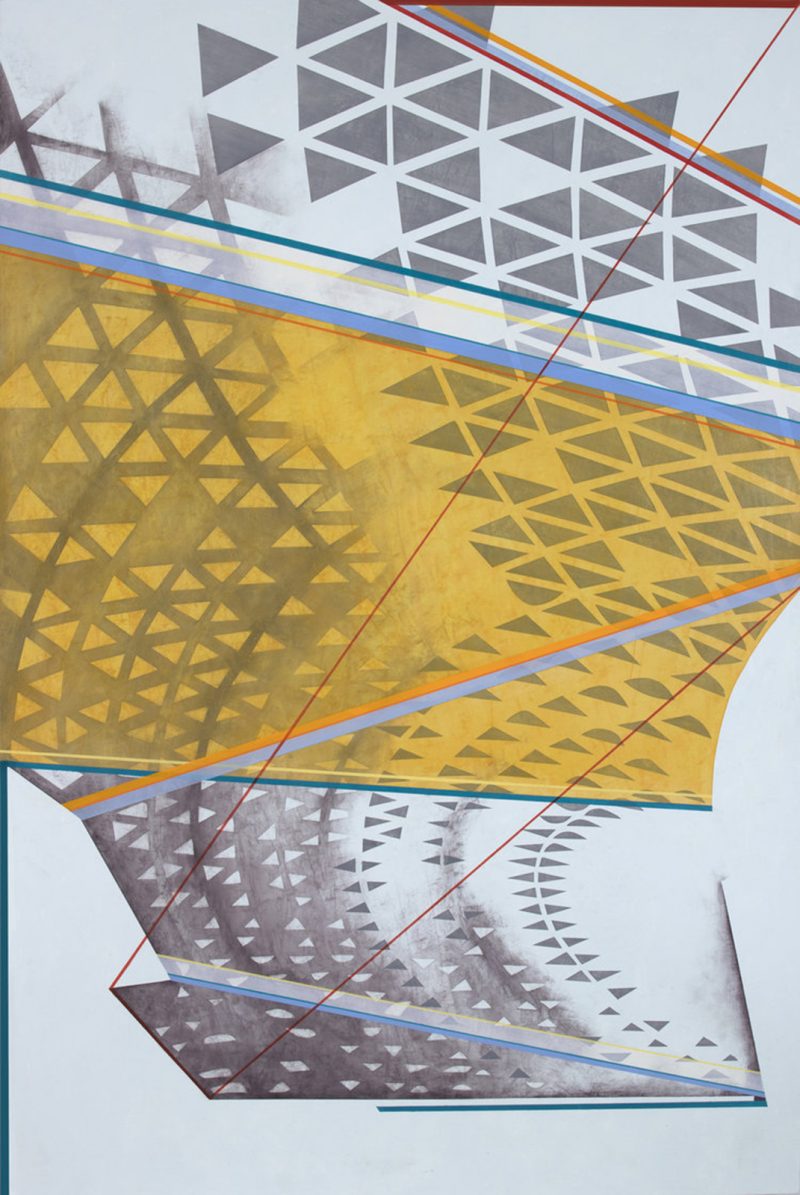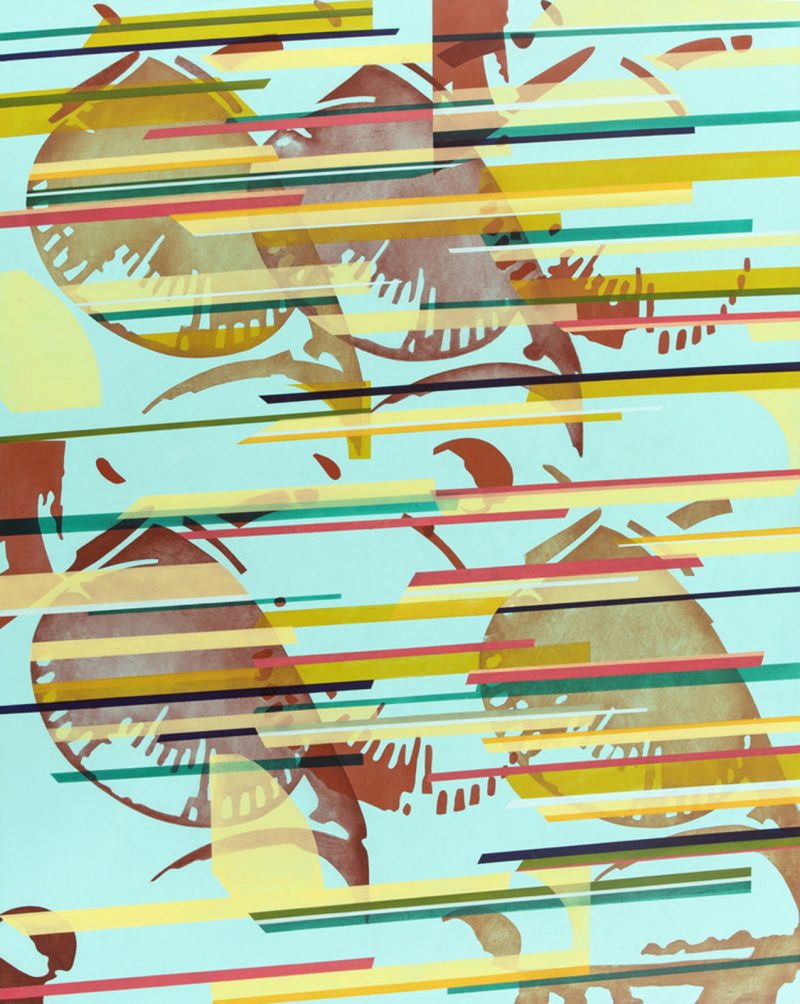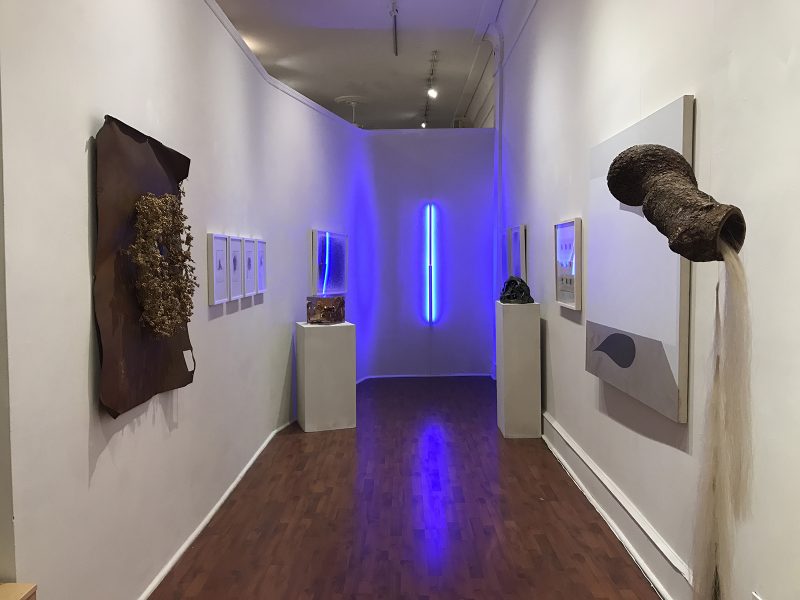Geometric Abstraction has manifested itself since the 7th century in Islamic architecture that included non-figural motifs within its design and decoration, and evolved throughout the 20th century, inspiring artists like Mondrian, Malevich, and Kandinsky to simplify and reduce traditional compositions to basic line, form, and color. This reductive approach continues to challenge contemporary artists such as Paul Fabozzi, whose latest paintings and drawings from the series Curved Locators investigate architectural landmarks of cities he has visited, observed, analyzed, and interpreted. In his first solo show at Seraphin Gallery, Fabozzi offers a mix of fourteen large-scale oil paintings and drawings of reimagined architecture.
“Intuitive reckoning”
Fabozzi’s paintings pulsate with visual energy. He has selected a series of monuments, seeking to connect the viewer to the role and function of each one. From the British Museum in London, to the Hagia Sophia in Istanbul, each edifice’s original three-dimensional representation seems to have dissolved into a complex pattern and two-dimensional spatial play of geometric shapes, hard-edged lines, and layers of color on the canvas. This approach enables the artist to find an architectural orderliness within the canvas, to subtly source and draw out the essence of each structure as he recalls it from his past excursions to the site. Fabozzi’s constructed compositions largely fall within the realm of imagined interpretations of geometric abstraction.

Fabozzi says that his paintings and drawings, “are a tactile and visual record of my intuitive reckoning with these spaces—a way of forcing them to look back at me.” “British Museum #2” (2016) demonstrates this. Having visited the British Museum, I could immediately relate to the physical presence and changing vistas within this monument, represented in the painting by a multitude of triangular shapes. These shapes combine to form a seductive curve echoing the monument’s glass roof that covers the Queen Elizabeth II Great Court and wraps around the famous Reading Room, partially visible in a negative profile within the painting. The colored lines reinforce and segment the delicate and intricate layout of the crisscross pattern formed by the triangular shapes, suggesting the changing views and airiness one would see and feel if they were to walk around the Great Court.

Light and space
“Hagia Sophia #1” (2016) shows Fabozzi challenged by a monument that is not only immense in scale and rich with architectural history, but also renowned for its ability to reflect light almost everywhere in the uninterrupted nave, causing the massive dome to appear as if it’s floating above one of the largest interior spaces. Fabozzi foregrounds this abundant quality of light with diagonal lines of color that sweep across the entire canvas, simultaneously playing on the mosaic decorations of the Hagia Sophia’s interior. In the background of this painting are several iterations of one view of the main dome that really sets the painting in motion and suggests its scale through repetition. Fabozzi offers a visually simplified view of the interplay between magnificent aesthetics and geometry unique to Byzantine architecture that also leaves the viewer with a renewed curiosity.
The paintings in Fabozzi’s Curved Locators offer much more than intricate compositions of elemental geometric forms and colorful arrangements free from objective context; they represent a system by which the artist enters himself and the viewer into an ongoing conversation about the passionate feeling and geometric reasoning he has gathered from his pilgrimage to these historic cultural monuments.
Piet Mondrian showed us with his masterpiece, “Broadway Boogie Woogie” (1942-43), that he meant to capture the restless motion of the city using lines, squares, primary colors, and shades of grey on a flat plane. As the solid colored blocks asymmetrically combine and recombine they create a feeling of a pulsating rhythm and establish an order within the network of yellow conduits. Mondrian was influenced by the architecture of New York City as well as the jazz music of the time, which is evident in the visual improvised pulsing within the arrangement of the blocks.
Looking back at Fabozzi’s “British Museum #2,” the ideas behind abstraction and simplification are similarly employed by use of primary color, geometric elements such as triangles and lines arranged in some type of mathematical configuration, and the simplified view of the monument. Fabozzi’s work, however, takes a slightly different approach by creating a sense of depth when he introduces lines that connect and reconnect the reinvented spatial planes.

Paul Fabozzi: Curved Locators is showing at the Seraphin Gallery through January 29, 2017, and includes a bonus viewing of a small group show curated by Alyssa Laverda, Associate Director of Seraphin Gallery, that boasts a list of formidable talent and installed in the Gallery 2 space. The list of artists includes Arman, Natalie Alper, George Herms, James Inscho, Craig Kraft, Kate Stewart, Isaac Witkin, and Millicent Young.
Paul Fabozzi received his MFA from the University of Pennsylvania. He is currently a Professor of the Fine Arts at St. John’s University in Queens, New York.
Seraphin Gallery is located at 1108 Pine Street. Open Wednesday through Sunday, 10–5.










